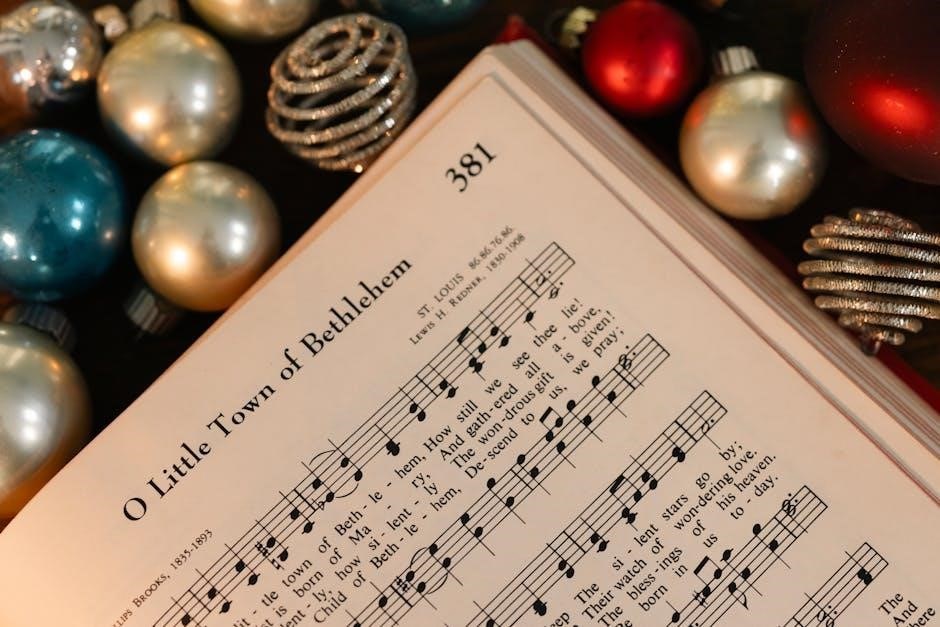Guide Me O Thou Great Redeemer Lyrics: A Comprehensive Guide
This iconic hymn, also known as “Bread of Heaven,” reflects deep trust in God’s guidance and strength. Its powerful lyrics resonate across cultures and generations, offering comfort and hope in times of uncertainty. Originating from Welsh roots, it has become a cherished anthem in worship and public events worldwide.

The hymn “Guide Me O Thou Great Redeemer,” also known as “Bread of Heaven,” is a powerful expression of faith and trust in God’s guidance. Originating from Welsh roots, it has become a beloved anthem worldwide, resonating with its themes of divine strength and deliverance. Written by William Williams and translated by Peter Williams, the hymn captures the journey of a pilgrim through life’s challenges, seeking God’s presence and sustenance. Its timeless lyrics, set to the iconic tune “Cwm Rhondda,” have made it a staple in worship, royal ceremonies, and even sporting events, symbolizing hope and endurance.

Historical Background of the Hymn
Written by William Williams in 1745, the hymn reflects his deep faith during his itinerant ministry. Translated by Peter Williams, it highlights Welsh cultural and spiritual heritage.
2.1. The Origins of “Guide Me O Thou Great Redeemer”
Composed in 1745 by William Williams, a Welsh Methodist minister, the hymn emerged during a period of spiritual awakening in Wales. Williams, inspired by his faith and missionary work, crafted the lyrics to express reliance on divine guidance. The hymn’s original Welsh title, “Arglwydd, Arwain Fi,” translates to “Lord, Lead Me On,” reflecting themes of trust and pilgrimage. Its creation marked a significant moment in Welsh religious music, blending personal devotion with communal worship. The hymn’s enduring appeal lies in its universal message of seeking strength and direction from a higher power, resonating across cultures and generations.
2.2. The Author and Translator: William Williams and Peter Williams
William Williams, a Welsh Methodist minister, penned the original hymn in 1745, titled “Arglwydd, Arwain Fi” (“Lord, Lead Me On”). His deep faith and missionary work inspired the lyrics, which reflect a personal journey of trust in God. Peter Williams, William’s nephew, later translated the hymn into English, preserving its spiritual essence while adapting it for broader audiences; This collaboration bridged linguistic and cultural gaps, allowing the hymn to resonate globally. Both men played pivotal roles in shaping a piece that remains a cornerstone of Christian worship, blending Welsh heritage with universal themes of divine guidance and strength.
2.3. The Hymn’s Welsh Heritage and Cultural Significance
The hymn “Guide Me O Thou Great Redeemer” holds a profound connection to Welsh culture, originating from the Welsh language hymn “Arglwydd, Arwain Fi” (“Lord, Lead Me On”), written by William Williams in 1745. This hymn became a cornerstone of Welsh Methodist worship, reflecting the spiritual resilience and faith of the Welsh people. Its translation into English by Peter Williams expanded its reach, blending Welsh heritage with universal Christian themes. The hymn’s association with the iconic “Cwm Rhondda” tune further cemented its cultural significance, making it a beloved anthem in Wales and beyond. Its use in royal events, sports, and public gatherings underscores its enduring impact on Welsh identity and global worship traditions.

Theological Themes in the Lyrics
The hymn emphasizes trust in God’s power, divine deliverance, and strength amidst life’s trials. It reflects a deep reliance on faith, hope, and eternal praise through mortality.
3.1. Trust in God’s Power and Guidance
The hymn profoundly expresses trust in God’s power and guidance, reflecting a pilgrim’s journey through life’s barren lands. The lyrics “I am weak, but thou art mighty” highlight human dependence on divine strength. The plea to “hold me with thy powerful hand” underscores a deep reliance on God’s care. The imagery of the “crystal fountain” and “fiery cloudy pillar” symbolizes divine guidance and sustenance. This trust is not passive; it is an active surrender to God’s will, seeking strength for life’s trials and ultimate deliverance. The hymn’s theology emphasizes that true trust in God leads to enduring hope and assurance, even in mortality’s shadow.
3.2. The Concept of Deliverance and Strength
The hymn vividly portrays the concept of deliverance and strength, emphasizing God’s role as a “strong Deliverer.” The lyrics plead for divine intervention, seeking refuge in God’s power to overcome life’s challenges. The imagery of the “crystal fountain” and “healing streams” symbolizes spiritual renewal and deliverance. The line “bear me through the swelling current” reflects trust in God’s strength to navigate life’s turbulent waters. The hymn’s recurring theme of divine deliverance underscores the belief that God is both a shield and a source of unwavering strength, enabling believers to face trials with courage and resilience, ultimately leading them to eternal praise and glory.

3.3. The Journey Through Life’s Trials and Mortality
The hymn metaphorically captures the journey through life’s trials and the inevitability of mortality. The lyrics, such as “pilgrim through this barren land,” symbolize the challenges and hardships faced during one’s earthly journey. The request to “bear me through the swelling current” reflects the desire for divine assistance in navigating life’s turbulent waters. The hymn also touches on mortality with the line “When I tread the verge of Jordan,” referencing the river symbolizing the transition to eternal life. This verse conveys trust in God’s guidance even in death, offering hope and assurance of safe passage to “Canaan’s side,” where eternal praise awaits. The hymn thus provides comfort and strength for believers facing life’s trials and mortality.

Musical Aspects of the Hymn
The hymn is set to the iconic Welsh tune “Cwm Rhondda,” known for its powerful and uplifting melody. Its harmonious structure complements the lyrical themes of trust and hope.
4.1. The Tune “Cwm Rhondda” and Its Popularity
The hymn is famously set to the tune “Cwm Rhondda”, composed by John Hughes in 1907. This powerful and uplifting melody has become iconic, perfectly complementing the hymn’s themes of trust and deliverance. The tune’s harmonious structure and soaring chorus have made it a favorite in worship and public gatherings. Its association with Guide Me O Thou Great Redeemer has elevated its popularity globally, with performances at royal events, sporting matches, and significant cultural ceremonies. The tune’s emotional depth and grandeur continue to resonate, making it a beloved choice for both sacred and secular occasions, further cementing its place in musical history.
4.2. The Hymn’s Use in Royal Occasions and Sporting Events
Guide Me O Thou Great Redeemer has transcended traditional worship, becoming a beloved anthem at royal ceremonies and sporting events. Its powerful lyrics and stirring melody evoke national pride and unity. Notably, it was performed at Queen Elizabeth II’s wedding in 1947 and features prominently during Welsh rugby matches. The hymn’s emotional resonance and grandeur make it a fitting choice for such occasions, symbolizing hope and resilience. Its adaptability to both sacred and secular contexts highlights its enduring appeal, bridging cultural and generational divides. This versatility ensures its continued relevance in modern celebrations, reinforcing its status as a cherished anthem worldwide.

Cultural Impact and Usage
Guide Me O Thou Great Redeemer holds a profound cultural significance, transcending its religious origins to become a cherished anthem in Wales and beyond, symbolizing hope and resilience.
5.1. The Hymn’s Role in Christian Worship
Guide Me O Thou Great Redeemer is a cornerstone of Christian worship, offering solace and inspiration to believers. Its themes of trust in God’s power and deliverance resonate deeply, making it a favorite in church services. The hymn’s rich, evocative language and soaring melody create a sense of communal prayer, uniting congregations worldwide. Often sung during pivotal moments like funerals, weddings, and celebrations, it provides comfort and hope. Its inclusion in hymnals and its adaptation into various musical styles ensure its relevance across generations, solidifying its place as a timeless anthem of faith and devotion in Christian traditions.
5.2. Its Performance in Notable Events and Services
Guide Me O Thou Great Redeemer has been a fixture in high-profile events, cementing its cultural and spiritual significance. It was prominently featured at the RAF Centenary Service at Westminster Abbey, showcasing its national importance. The hymn’s powerful melody and poignant lyrics have also been performed by celebrated artists like Charlotte Church, further amplifying its reach. In sporting contexts, it is famously sung at Welsh rugby matches, embodying national pride. Its appearance at royal occasions and state funerals underscores its enduring relevance. These performances highlight the hymn’s ability to transcend traditional worship, resonating with diverse audiences and solidifying its place in both sacred and secular celebrations.

The Lyrics and Their Meaning
Guide Me O Thou Great Redeemer explores themes of trust, divine guidance, and spiritual nourishment. Its verses depict a pilgrim’s journey through life’s challenges, seeking strength from God.
6.1. The First Verse: A Pilgrim’s Journey
The first verse of Guide Me O Thou Great Redeemer vividly portrays a pilgrim’s journey through a barren land, symbolizing life’s challenges. The lyrics express weakness and reliance on God’s might, seeking divine guidance and strength. The phrase “bread of heaven, feed me now and evermore” reflects a deep longing for spiritual nourishment and eternal sustenance. This verse establishes the hymn’s central theme of trust in God’s power and provision, resonating with believers facing life’s trials. Its imagery and emotion set the tone for the rest of the hymn, inviting listeners to surrender to God’s care and leadership.
6.2. The Second Verse: The Crystal Fountain and Divine Guidance
The second verse of Guide Me O Thou Great Redeemer introduces the imagery of a “crystal fountain” and “living waters,” symbolizing spiritual cleansing and divine refreshment. The lyrics petition God to open this fountain, emphasizing the need for continuous guidance. The “fiery, cloudy pillar” references the Exodus, where God led His people, reinforcing the theme of divine leadership. This verse seeks assurance of God’s presence and strength throughout life’s journey, blending elements of deliverance and trust. Its rich imagery invites believers to rely on God’s enduring guidance, even in uncertain times, while the fountain serves as a metaphor for spiritual renewal and sustenance. The verse deepens the hymn’s message of reliance on divine providence.
6.3. The Third Verse: Crossing the Jordan and Eternal Praise
The final verse of Guide Me O Thou Great Redeemer symbolizes the ultimate journey of faith—crossing the Jordan, an act representing both death and eternal life. The lyrics express a desire for God’s deliverance from fear and anxiety, seeking safe passage to “Canaan’s side,” a land of promise and rest. This verse emphasizes unwavering faith and the assurance of eternal praise, where the believer commits to offering perpetual thanks to God. The imagery of “songs of praises” highlights the joy and gratitude that characterize the afterlife. This verse serves as a powerful conclusion, encapsulating the hymn’s themes of trust, deliverance, and eternal worship, resonating deeply with those facing life’s final transition.

The Hymn’s Legacy
The hymn’s timeless appeal endures, inspiring faith across generations. Its use in royal and sporting events highlights its cultural significance, with adaptations keeping it relevant today.
7.1. Its Enduring Popularity in Modern Times
The hymn remains a beloved and iconic piece, resonating deeply with modern audiences. Its powerful lyrics and soaring melody continue to inspire faith and hope in contemporary settings. Featured in royal ceremonies, sporting events, and even contemporary performances by artists like Charlotte Church, it bridges generations. The hymn’s adaptability has led to various versions, ensuring its relevance in today’s diverse cultural landscape. Its emotional depth and timeless message of trust in God’s guidance make it a cherished anthem for many, transcending traditional worship to touch hearts in new and innovative ways.
7.2. Adaptations and Contemporary Versions
The hymn has undergone numerous adaptations, blending traditional and modern styles. Notable renditions include performances by Charlotte Church, showcasing its timeless appeal. Contemporary Christian artists have reimagined the hymn, infusing it with fresh musical arrangements while preserving its core message. Its versatility extends to various languages and cultural interpretations, ensuring its global reach. The hymn’s melody, often set to “Cwm Rhondda,” has been rearranged for orchestral and choral performances, further enhancing its universal appeal. These adaptations highlight its enduring relevance, allowing new generations to connect with its powerful themes of faith and deliverance. Its evolution ensures it remains a cherished piece in both traditional and modern contexts.




